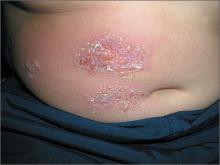The FP diagnosed bullous impetigo with surrounding cellulitis. The most likely cause was Staphylococcus aureus. Honey crusts are typical of impetigo, a superficial bacterial infection of the skin. Bullae are less common in impetigo and should be a tip-off that methicillin-resistant Staphylococcus aureus (MRSA) is involved. In this case, the surrounding erythema indicated that the infection might have penetrated deeper into the dermis, producing a coexisting cellulitis.
If MRSA is suspected, some clinicians culture the lesions while starting an appropriate antibiotic. However, this is not necessary if the antibiotic choice is effective against MRSA. In one randomized controlled trial, trimethoprim-sulfamethoxazole achieved 100% clearance in the treatment of impetigo in children cultured with MRSA and group A β-hemolytic Streptococcus.
The 2 best treatment choices for children of this age with bullous impetigo are trimethoprim-sulfamethoxazole or clindamycin. They are both available in oral liquid preparations as generic medicines.
The FP chose to give the child trimethoprim-sulfamethoxazole twice daily (as there is less resistance to this compared to clindamycin) for 10 days. The physician also discussed hygiene issues with the mother and how to avoid the condition from spreading within the household. The FP told the mother to bring the child back if she didn’t notice an improvement within 2 days. The FP called the home 2 days later and learned that the child was significantly better. The bullous impetigo and cellulitis fully resolved within 10 days.
Photo and text for Photo Rounds Friday courtesy of Richard P. Usatine, MD. This case was adapted from: Usatine R. Impetigo. In: Usatine R, Smith M, Mayeaux EJ, et al, eds. Color Atlas of Family Medicine. 2nd ed. New York, NY: McGraw-Hill; 2013:676-679.
To learn more about the Color Atlas of Family Medicine, see: www.amazon.com/Color-Family-Medicine-Richard-Usatine/dp/0071769641/
You can now get the second edition of the Color Atlas of Family Medicine as an app by clicking on this link: usatinemedia.com


